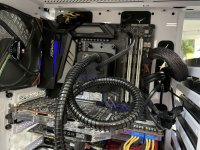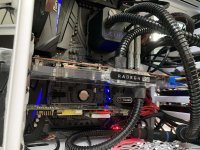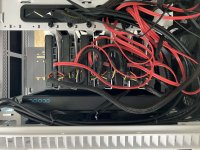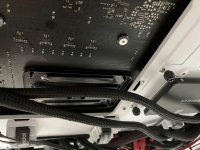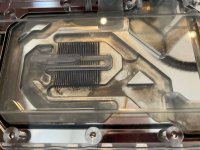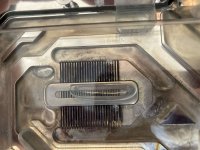Dorstlesser
New member

Main Specs:
Dear all,
I've been running the Eisbaer 280 on my CPU with additional GPU block for a while now and while GPU temps have been amazing the CPU temps were always a bit on the high side with max 78C under load on 'ECO'. I applied some more thermal paste and refastened the cooler and CPU temps dropped a couple of degrees, which suggested that initially I had been too conservative with the thermal paste and fastening...
Recently I tried Ryzen Clock Tuner for which I turned off ECO mode and noticed CPU temps going to 90C in Cinebench and even 95C in AIDA64 stress test. I'm running the CPU at default settings and PBO is not turned on.
I'm wondering if the cause could be mounting pressure? I have followed the manual for AM4 mounting, put both 2mm and .5mm washers in place and I can not apply more pressure because the springs are completely pressed. I hope you can help.
Water flow is from radiator > pump/CPU > GPU > back to radiator. To confirm: GPU load does not lead to increased CPU temps but vice versa it does. GPU temps suggest pump works normally; max RPM is around 2700. Temperature in the case is between 30-35C.
What would be your advice?
Thanks,
Paul
- Mobo: ASrock X470 Taichi
- CPU: Ryzen 3900X
- GPU: Radeon RX5700
- Case: Fractal Design Define 7
- Eisbaer 280 CPU cooler (with DC-LT 2 Ceramic pump)
- Eisblock Aurora for GPU
- Quick-connect extension kit
- Casefans: 3 x 140 mm intake, 2 x 140 mm outtake on radiator
Dear all,
I've been running the Eisbaer 280 on my CPU with additional GPU block for a while now and while GPU temps have been amazing the CPU temps were always a bit on the high side with max 78C under load on 'ECO'. I applied some more thermal paste and refastened the cooler and CPU temps dropped a couple of degrees, which suggested that initially I had been too conservative with the thermal paste and fastening...
Recently I tried Ryzen Clock Tuner for which I turned off ECO mode and noticed CPU temps going to 90C in Cinebench and even 95C in AIDA64 stress test. I'm running the CPU at default settings and PBO is not turned on.
I'm wondering if the cause could be mounting pressure? I have followed the manual for AM4 mounting, put both 2mm and .5mm washers in place and I can not apply more pressure because the springs are completely pressed. I hope you can help.
Water flow is from radiator > pump/CPU > GPU > back to radiator. To confirm: GPU load does not lead to increased CPU temps but vice versa it does. GPU temps suggest pump works normally; max RPM is around 2700. Temperature in the case is between 30-35C.
What would be your advice?
Thanks,
Paul


